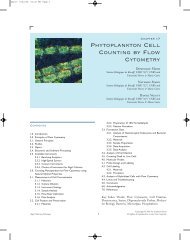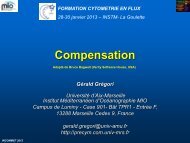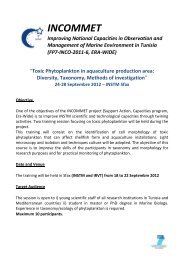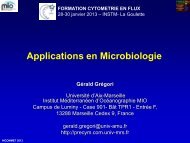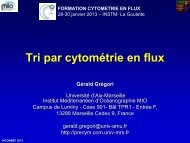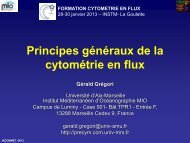Eukaryotic Picoplankton in Surface Oceans - incommet
Eukaryotic Picoplankton in Surface Oceans - incommet
Eukaryotic Picoplankton in Surface Oceans - incommet
You also want an ePaper? Increase the reach of your titles
YUMPU automatically turns print PDFs into web optimized ePapers that Google loves.
Annu. Rev. Microbiol. 2011.65:91-110. Downloaded from www.annualreviews.org<br />
by CSIC - Consejo Superior de Investigaciones Cientificas on 09/27/11. For personal use only.<br />
2. Despite be<strong>in</strong>g morphologically similar, picoeukaryotes <strong>in</strong>clude different organisms. The<br />
large diversity detected at all phylogenetic scales is accompanied by the discovery of novel<br />
groups, such as MAST, MALV, and picobiliphytes.<br />
3. Phototrophic cells affiliate mostly with haptophytes, chrysophytes, and pelagophytes <strong>in</strong><br />
the open sea, and with pras<strong>in</strong>ophytes at the coast. Less is known for heterotrophic cells,<br />
which may be dom<strong>in</strong>ated by MAST, MALV, cercomonads, and chrysophytes.<br />
4. There is no evidence of dispersal barriers <strong>in</strong> surface oceans, so picoeukaryotes appear<br />
globally distributed and constra<strong>in</strong>ed by environmental filter<strong>in</strong>g. Therefore, communities<br />
appear similarly organized <strong>in</strong> similar environmental conditions.<br />
5. Picoeukaryote diversity is currently underestimated mostly due to the rare biosphere,<br />
which can be partially expla<strong>in</strong>ed by <strong>in</strong>tragenomic variability and methodological errors.<br />
FUTURE ISSUES<br />
1. There is a need to fully characterize picoeukaryote diversity by high-throughput tag<br />
sequenc<strong>in</strong>g and -omic approaches. Environmental sequences should be classified <strong>in</strong>to<br />
taxonomic groups to assess <strong>in</strong>tragroup diversity and identify novel groups.<br />
2. It is important to understand which degree of environmental sequence variation is evolutionary<br />
and ecologically relevant by l<strong>in</strong>k<strong>in</strong>g that variation to cells with ecological roles.<br />
The f<strong>in</strong>al aim is to establish the diversity levels important for ecosystem functions.<br />
3. More attention should be paid to the factors controll<strong>in</strong>g the abundance of particular<br />
populations and the rules of community assembly. This should be studied at different<br />
spatial and temporal scales.<br />
DISCLOSURE STATEMENT<br />
The author is not aware of any affiliations, memberships, fund<strong>in</strong>g, or f<strong>in</strong>ancial hold<strong>in</strong>gs that might<br />
be perceived as affect<strong>in</strong>g the objectivity of this review.<br />
ACKNOWLEDGMENTS<br />
The author acknowledges J.M. Gasol, R. Logares, J.M. Montoya, and C. Pedrós-Alió for critical<br />
read<strong>in</strong>g of the manuscript. Fund<strong>in</strong>g has been provided by FLAME (CGL2010-16304, MICINN,<br />
Spa<strong>in</strong>) and BioMarKs (2008-6530, ERA-net Biodiversa, EU) projects.<br />
LITERATURE CITED<br />
1. Ac<strong>in</strong>as SG, Klepac-Ceraj V, Hunt DE, Phar<strong>in</strong>o C, Ceraj I, et al. 2004. F<strong>in</strong>e-scale phylogenetic architecture<br />
of a complex bacterial community. Nature 430:551–54<br />
2. Agaw<strong>in</strong> NSR, Duarte CM, Agustí S. 2000. Nutrient and temperature control of the contribution of<br />
picoplankton to phytoplankton biomass and production. Limnol. Oceanogr. 45:591–600<br />
3. Alverson AJ, Kolnick L. 2005. Intragenomic nucleotide polymorphism among small subunit (18S) rDNA<br />
paralogs <strong>in</strong> the diatom genus Skeletonema (Bacillariophyta). J. Phycol. 41:1248–57<br />
106 Massana



